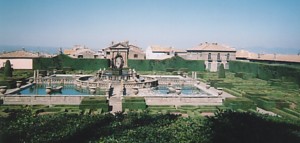Bagnaia Tourist and Travel Guide
Bagnaia is a small and charmingly historical town in Northern Lazio, in the Province of Viterbo. Bagnaia is just a short distance from Viterbo, and can be reached quickly and easily by car or bus. From Rome you should travel to Viterbo (bus or train) and change to the local bus service.
The town is famous for its great relic of aristocratic grandeur (one of several in this part of Lazio), the sixteenth-century Villa Lante. As is often the case in Italy, the term ‘villa’ is misleading, because it’s really the garden for which the place is famous. One of Italy’s greatest gardens, Villa Lante is open to the public and, combined with a leisurely lunch and a wander around the town, makes a lovely day out. Alternatively, those extremely keen on gardens and houses and with a hired car (or taxi funds) could combine it in a busy day (or two) with the Villa Farnese at Caprarola and the enigmatic ‘Monster Garden’ at Bomarzo.
Bagnaia Tourist Attractions and Holiday Information
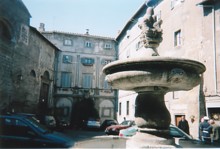
For practical, scenic, and tourist purposes, the most important part of Bagnaia is the town’s main square, Piazza XX Settembre. This piazza is on the rise at the heart of the historic town, and here you’ll find the Bagnaia tourist information office (very helpful when you ask for information written in English), bus stop, bars and gelateria. The town was re-laid out in 1567, including three streets laid out between the centre and the Villa in trident formation, said to be inspired by the famous ‘tridente’ at Piazza del Popolo, Rome.
Around the piazza and the road leading to the Villa Lante are several eating places. You could enjoy a leisurely lunch in the trattoria or pizzeria, or opt for the cheaper take-away pizza option. There is also a small general store, so you could buy food to rustle up a picnic in the large and appealing park by the villa entrance. Once you get past the spectacular fountain and the old hunting lodge, the park becomes quite wild, and you can explore copses of trees and dilapidated water features – a great place for children (or adults) to play.
Villa Lante
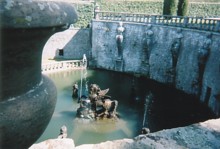
Head from the main piazza up the right-hand of the three ‘trident’ streets. You’ll arrive at the entrance, dominated by an impressive theatrical fountain with statue of Pegasus – pictured – to the public park that was once part of the grounds of the Villa. The ticket office for the gardens is here, along with the visitor toilets, and the entrance is through a gate further up the slope.
The Villa Lante (not the only one in Italy) is named after the Lante della Rovere family, who owned the estate for three centuries until 1933. Earlier, the property went with the position of Bishop of Viterbo, and it was the holders of this august position who were responsible for the pleasure grounds you can enjoy today.
At the beginning of the 16th Century, Cardinal Raffaele Riario began creating Villa Lante, when he had a wall built to enclose 22 hectares of land. This came to include a garden and an adjacent hunting reserve, which is now a public park. Subsequent owners, most notably one Cardinal De Gambara, continued the work, commissioning improvements that have resulted in what is praised as one of Italy’s finest Renaissance gardens. Gambara is close to the Italian word for ‘shrimp’, and the Cardinas’s rather entertaining shrimp emblem can be seen around the garden and buildings. Vignola is said to have designed the gardens, although there is a lack of documentary proof for this tradition. Much of the credit goes to the Sienese architect Tommaso Ghinucci, who also completed Bagnaia’s urban planning.
The base of the garden is a formal Italian garden, arranged around the impressive Fontana del Quadrato or Fontana dei Quattro Mori, a lavishly embellished fountain surrounded by an expanse of water, complete with stone boats.
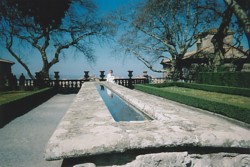
Above this formal garden, the property extends upwards 16 metres, in a number of differently-decorated levels. On either side stand twin buildings, the palazzine. These two villas, one to each side of the gardens, have frescoed interiors which have been furnished in keeping with their era. A lower-level loggia contains some charming frescoes – sadly damaged – showing this and other local gardens and villas.
As the garden rises in steps, the mood changes. Water runs down through a variety of lively fountains and water features, and trees and hedges offer shade. The visitor can enjoy a series of different panoramas as they pause at each level. A long stone ‘table’ halfway up is said to be where the cardinals could entertain guests at feasts, keeping wine bottles cool in the central trough (and presumably their feet cool in the water channel below); a lovely idea whether or not it is true.
Bagnaia Travel
Get to Bagnaia
Bagnaia is 80km from Rome, 4km from Viterbo and 20km from Orte. If you are driving from Rome, you should take the Via Cassia to Viterbo, then follow signs. Similarly, if you are using public transport you should get from Rome to Viterbo, then take a local bus for the last leg of your journey. It may be worth checking train times, but they are likely to be few and far between. If you are driving along the Autostrada del Sole (A1) you should leave at the Orte exit.
Bagnaia Accommodation
Bagnaia is a very small town. If you want to stay in the area, your best bet is probably to opt for Viterbo, the provincial capital. It’s a small town but large enough to provide hospitality and entertainment. Alternatively, if you have a car, you could choose a quiet agriturismo or a base near one of the local lakes.
> Accommodation around Bagnaia
Bagnaia Festivals and Events
At Easter, Bagnaia lays on a reenactment of the Crucifixion, no less. On Good Friday (Venerdi Santo), there is an evening procession in historical costume around the streets of Bagnaia culminating in the heart of the historic centre. Costumed performers recreate scenes from the biblical account of Easter.
August – Agosto Bagnaiolo involves celebrations of the patron saint, St. Rocco, and events including a porchetta (roast pig) festival, and medieval re-enactments. There is also a steak festival from 30 August – 4 September.
More processions, religious in theme, take place on the first Tuesday after Easter, the first Sunday after Corpus Christi, the first Sunday of October. On 17 January there is a Blessing of the Animals, and on the third Sunday in June a livestock fair takes place.
Guides to Bagnaia, Lazio and Italian gardens
The Garden Lover’s Guide to Italy
A good guide written by Penelope Hobhouse with a thorough run-down of the best gardens in Italy, including descriptions and practical details.
Buy The Garden Lover’s Guide to Italy from Amazon.co.uk
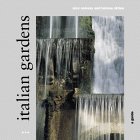
Italian Gardens
A handy guide to the best gardens in Italy, with descriptions, history and practical information.
Lazio destinations
- About the Lazio region
- Anzio
- Bracciano
- Calcata
- Castel Gandolfo
- Castelli Romani
- Cerveteri
- Formia
- Frascati
- Gaeta
- Palestrina
- Pontine islands
- Ponza
- Rome
- Sperlonga
- Terracina
- Tivoli
- Ventotene
- Viterbo
